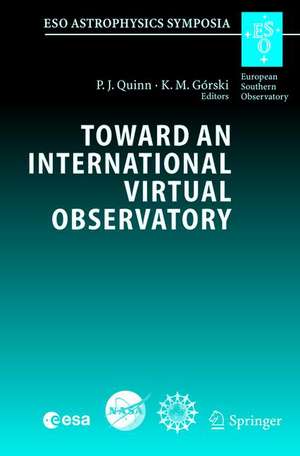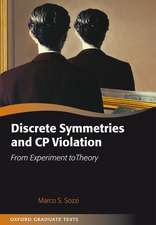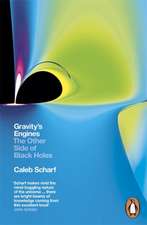Toward an International Virtual Observatory: Proceedings of the ESO/ESA/NASA/NSF Conference Held at Garching, Germany, 10–14 June 2002: ESO Astrophysics Symposia
Editat de Peter J. Quinn, Krzysztof M. Górskien Limba Engleză Hardback – 9 iul 2004
| Toate formatele și edițiile | Preț | Express |
|---|---|---|
| Paperback (1) | 643.84 lei 6-8 săpt. | |
| Springer Berlin, Heidelberg – 23 aug 2014 | 643.84 lei 6-8 săpt. | |
| Hardback (1) | 649.06 lei 6-8 săpt. | |
| Springer Berlin, Heidelberg – 9 iul 2004 | 649.06 lei 6-8 săpt. |
Din seria ESO Astrophysics Symposia
- 15%
 Preț: 656.43 lei
Preț: 656.43 lei - 15%
 Preț: 656.10 lei
Preț: 656.10 lei -
 Preț: 369.78 lei
Preț: 369.78 lei -
 Preț: 404.51 lei
Preț: 404.51 lei - 15%
 Preț: 644.95 lei
Preț: 644.95 lei - 15%
 Preț: 656.43 lei
Preț: 656.43 lei -
 Preț: 391.97 lei
Preț: 391.97 lei - 18%
 Preț: 971.01 lei
Preț: 971.01 lei -
 Preț: 434.94 lei
Preț: 434.94 lei - 15%
 Preț: 650.86 lei
Preț: 650.86 lei -
 Preț: 402.98 lei
Preț: 402.98 lei -
 Preț: 403.90 lei
Preț: 403.90 lei -
 Preț: 412.78 lei
Preț: 412.78 lei - 15%
 Preț: 645.47 lei
Preț: 645.47 lei -
 Preț: 431.30 lei
Preț: 431.30 lei -
 Preț: 402.56 lei
Preț: 402.56 lei - 15%
 Preț: 647.27 lei
Preț: 647.27 lei -
 Preț: 413.15 lei
Preț: 413.15 lei -
 Preț: 409.30 lei
Preț: 409.30 lei -
 Preț: 430.10 lei
Preț: 430.10 lei -
 Preț: 406.42 lei
Preț: 406.42 lei - 15%
 Preț: 658.05 lei
Preț: 658.05 lei - 20%
 Preț: 590.37 lei
Preț: 590.37 lei -
 Preț: 400.65 lei
Preț: 400.65 lei -
 Preț: 413.15 lei
Preț: 413.15 lei - 15%
 Preț: 658.70 lei
Preț: 658.70 lei -
 Preț: 401.79 lei
Preț: 401.79 lei -
 Preț: 436.70 lei
Preț: 436.70 lei -
 Preț: 404.13 lei
Preț: 404.13 lei
Preț: 649.06 lei
Preț vechi: 763.60 lei
-15% Nou
Puncte Express: 974
Preț estimativ în valută:
124.19€ • 130.04$ • 103.01£
124.19€ • 130.04$ • 103.01£
Carte tipărită la comandă
Livrare economică 10-24 aprilie
Preluare comenzi: 021 569.72.76
Specificații
ISBN-13: 9783540210016
ISBN-10: 3540210016
Pagini: 372
Ilustrații: XXII, 344 p. 71 illus.
Dimensiuni: 155 x 235 x 26 mm
Greutate: 0.66 kg
Ediția:2004
Editura: Springer Berlin, Heidelberg
Colecția Springer
Seria ESO Astrophysics Symposia
Locul publicării:Berlin, Heidelberg, Germany
ISBN-10: 3540210016
Pagini: 372
Ilustrații: XXII, 344 p. 71 illus.
Dimensiuni: 155 x 235 x 26 mm
Greutate: 0.66 kg
Ediția:2004
Editura: Springer Berlin, Heidelberg
Colecția Springer
Seria ESO Astrophysics Symposia
Locul publicării:Berlin, Heidelberg, Germany
Public țintă
ResearchCuprins
Nineteenth and Twentieth Century Clouds-Over the Twenty-First Century Virtual Observatory.-Building the Infrastructure for the National Virtual Observatory.- An Astronomical Wide-Field Imaging System for Europe.-The Canadian Virtual Observatory Project.-Information Hub of the Russian Virtual Observatory.-Early Virtual Science: Some Lessons for the AVO.-The Great Observatories Origins Deep Survey: A VO Test Case?.- Visualizing and Analyzing Massive Astronomical Datasets with Partiview.-Science and the Grid.-National Virtual Observatory Architecture.-Authentication and Authorization Architecture for AstroGrid and the Virtual Observatory.- VO Activities at the Harvard-Smithsonian CfA.-The Prototype TNG Long-Term Archive and its Interactions with the Italian GRID Project.- Federation and Fusion of Astronomical Information:Standards and Tools for the Virtual Observatories.- Data Models for the VO.-Scalable Metadata Definition Frameworks.-Space-Time Metadata for the Virtual Observatory.-VOTable: Tabular Data for the Virtual Observatory.-A C-++ Parser for VOTables.-ASTROVIRTEL: Tools and Operations.-Towards an AVO Interoperability Prototype.-Inter-Operability of ESA Science Archives.- The AstroGrid Pilot Programme.-Making Ground-Based Optical/Infrared Imaging Surveys VO-Compatible.- e-Star: Telescopes and Databases as a Single Information Grid.-Massive Variability Search and Monitoring by OGLE and ASAS.-Statistical Analysis of Observed and Simulated Surveys.-Catalogue Intersection: Beyond Basic Cross Correlations.-Meeting the User Science Challenge for a Virtual Universe.-Theoretical Astrophysics and the US-NVO Initiative.-Artificial Intelligence Tools for Data Mining in Large Astronomical Databases.-Data Mining Facility.-Automatic Detection - Extraction – Classification fora Large Number of Stellar Spectra from Slitless Wide Field Spectroscopy. A Project for AVO.-Star-Forming Regions at High Resolution: Interferometry for Virtual Observatories.-TheAstronomical Data Warehouse.-The Real Astronomy Experience: Making the IVO Effective for International Planetaria and Science Centers.-Enabling Outreach with Virtual Observatories.- Poster Papers: Building the MEGA Image-Subtraction Pipeline in the Era of Virtual Observatories.-Visualisation Tools for Very Large Amounts of Data.-Laplacean Ideology for Preliminary Orbit Determination and Moving Celestial Body Identification in Virtual Epoch.-Using XML-Schema to Model Data from Present and Future Astronomical Databases.-The Virtual Observatory as a Tool to Study Star Cluster Populations in Starburst Galaxies.-The Master Catalogue of Stars Towards the Magellanic Clouds.-UCDs: Metadata for the VO.-Applicability of Emerging Resource Discovery Standards to the VO.-The Astronomy Digital Library and the VO.-The Digitized Hamburg Objective Prism Surveys.-Aladin in the VO Context.-Power Spectrum for the Distribution of Galaxies an the Sphere.-The World Space Observatory (WSO/UV) Archive: Requirements for Interoperation.- A Common Data Analysis Environment: Do We Need One?.-Multiwavelength Studies of AGN.-The CCD Sky Patrols and Plate Archives.-Wide-Field X-Ray Monitoring as Data Source for Virtual Observatory.-The UDAPAC Project - Uccle Direct Astronomical Plate Archive Centre: A New International Facility for Inherited Observations.-The Russian Virtual Observatory Portal. Convenience and Attractiveness.-IDHA Image Archive Model.-Building Interoperable NASA Archives.-iAstro: Computational and Information Infrastructure in the Astronomical DataGrid.-PRIME: A Deep Near-Infrared Survey Project.-Practical Approach to Catalogued-Data Visualisation.-Multi-Object Spectroscopy: Automatic Extraction and Previewing of Spectra.- The INTEGRAL Archive at the ISDC.-HyperLeda: Virtual Instruments for Extragalactic Astronomy.-A Galactic Model as a Useful Tool for Virtual Observatories.-The SolarWeb Semantic Data Model for Describing Relationships Between Heterogeneous Solar Database
Textul de pe ultima copertă
The book is the first thorough overview of the first important steps to develop a worldwide virtual observatory so that, in the future, it could be easier to "dial-up" a part of the sky than wait many months to access a telescope. The articles in this book present details on the status of the first efforts to develop a standardized framework for the virtual observatory, including steps towards completion and deployment of technical infrastructure, uptake by data providers worldwide, and utilization by the scientific community.
Caracteristici
Includes supplementary material: sn.pub/extras
















